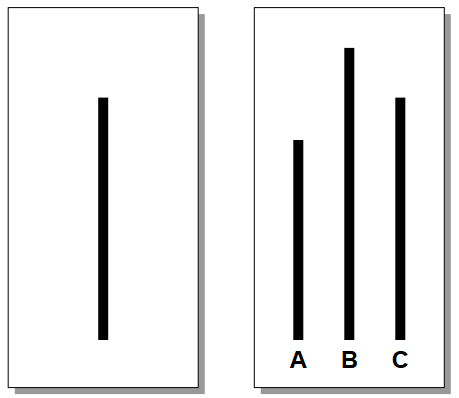Unit 5 - Perspectives and biases
Bias
Learn more about bias: 2 activities
 |
 |
Optional activity 1 |
Listen to this 30 minute interview with Tom Gilovich, a professor of psychology at Cornell University. Keep in mind what we have covered so far and make notes on any biases mentioned.
Video 'Episode 8 − Extraordinary Claims: Uncut conversation with Tom Gilovich' (7)
Click on "Reveal" to check your answers.
 |
 |
Optional activity 2 |
Read the text below about conformity bias, which is our tendency to behave similarly to the others in a group, even if doing so goes against our own judgement.
The Asch conformity experiments refer to a series of studies by Solomon Asch studying if and how individuals yielded to or defied a majority group and the effect of such influences on beliefs and opinions. Asch conducted his first conformity laboratory experiments at Swarthmore College, USA, in 1951, laying the foundation for his later conformity studies.
In this experiment, groups of 8 male college students participated in a simple perceptual task. In reality, all but one of the participants were actors - something the 1 test individual (the subject) did not know. The true focus of the study was about how the subject would react to the actors' behaviour. The actors knew the true aim of the experiment, but were introduced to the subject as other participants.
Each participant viewed a card with a line on it, followed by another with 3 lines labelled A, B, and C (see figure below).

One of these lines was the same as that on Card 1, and the other 2 lines were clearly longer or shorter. One would expect a near-100% correct response for such a simple task.
Each participant was then asked to say aloud which line matched the length of that on Card 1. Before the experiment, all actors were given specific instructions on how they should respond in each trial. They would always unanimously call the same line, but on some trials they would give the correct response and on others an incorrect response. The group was seated such that the subject always responded last.
Each subject completed 18 trials. On the first 2 trials (the control group), both the subject and the actors gave the obvious, correct answer. On the 3rd trial, the actors would all give the same wrong answer. This incorrect response occurred on all the remaining 15 trials. It was the subjects' behaviour on these 15 critical trials that formed the aim of the study: to test how many subjects would change their answer to conform to those of the 7 actors, despite the answer being wrong.
Asch expected that the majority of subjects would not conform to saying something clearly incorrect, but the results showed that as many as 75% conformed at least once, and 5% conformed every time. In the control group (the first 2 trials), with no pressure to conform to fellow participants, less than 1% of participants gave the wrong answer.
Subjects were interviewed and debriefed afterwards about the true purpose of the study. These post-test interviews shed valuable light on the study, both because they revealed subjects often were 'just going along' and because they revealed considerable individual differences.
Note that Asch used a biased sample in this experiment – all subjects were male, belonging to the same age group. In addition, one needs to keep in mind the political context at the time when the experiment was conducted. In the 1950s, the US was highly conservative, and so people holding left-wing views were being accused of being communist and put on trial. The suggestion is that people were reluctant to be seen as not conforming.